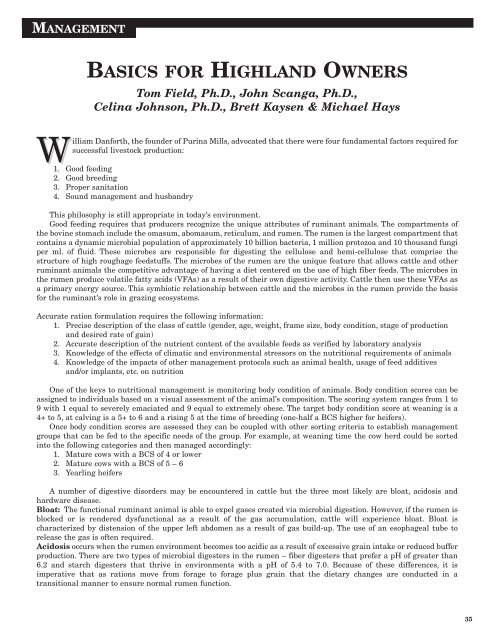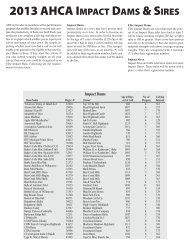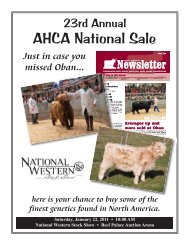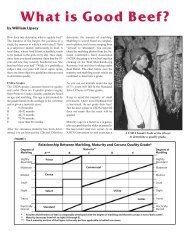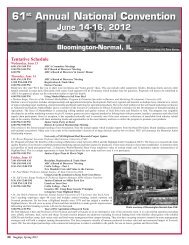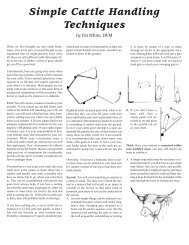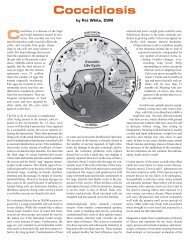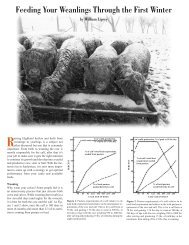The Bagpipe - American Highland Cattle Association
The Bagpipe - American Highland Cattle Association
The Bagpipe - American Highland Cattle Association
You also want an ePaper? Increase the reach of your titles
YUMPU automatically turns print PDFs into web optimized ePapers that Google loves.
MANAGEMENT<br />
BASICS FOR HIGHLAND OWNERS<br />
Tom Field, Ph.D., John Scanga, Ph.D.,<br />
Celina Johnson, Ph.D., Brett Kaysen & Michael Hays<br />
William Danforth, the founder of Purina Mills, advocated that there were four fundamental factors required for<br />
successful livestock production:<br />
1. Good feeding<br />
2. Good breeding<br />
3. Proper sanitation<br />
4. Sound management and husbandry<br />
This philosophy is still appropriate in today’s environment.<br />
Good feeding requires that producers recognize the unique attributes of ruminant animals. <strong>The</strong> compartments of<br />
the bovine stomach include the omasum, abomasum, reticulum, and rumen. <strong>The</strong> rumen is the largest compartment that<br />
contains a dynamic microbial population of approximately 10 billion bacteria, 1 million protozoa and 10 thousand fungi<br />
per ml. of fluid. <strong>The</strong>se microbes are responsible for digesting the cellulose and hemi-cellulose that comprise the<br />
structure of high roughage feedstuffs. <strong>The</strong> microbes of the rumen are the unique feature that allows cattle and other<br />
ruminant animals the competitive advantage of having a diet centered on the use of high fiber feeds. <strong>The</strong> microbes in<br />
the rumen produce volatile fatty acids (VFAs) as a result of their own digestive activity. <strong>Cattle</strong> then use these VFAs as<br />
a primary energy source. This symbiotic relationship between cattle and the microbes in the rumen provide the basis<br />
for the ruminant’s role in grazing ecosystems.<br />
Accurate ration formulation requires the following information:<br />
1. Precise description of the class of cattle (gender, age, weight, frame size, body condition, stage of production<br />
and desired rate of gain)<br />
2. Accurate description of the nutrient content of the available feeds as verified by laboratory analysis<br />
3. Knowledge of the effects of climatic and environmental stressors on the nutritional requirements of animals<br />
4. Knowledge of the impacts of other management protocols such as animal health, usage of feed additives<br />
and/or implants, etc. on nutrition<br />
One of the keys to nutritional management is monitoring body condition of animals. Body condition scores can be<br />
assigned to individuals based on a visual assessment of the animal’s composition. <strong>The</strong> scoring system ranges from 1 to<br />
9 with 1 equal to severely emaciated and 9 equal to extremely obese. <strong>The</strong> target body condition score at weaning is a<br />
4+ to 5, at calving is a 5+ to 6 and a rising 5 at the time of breeding (one-half a BCS higher for heifers).<br />
Once body condition scores are assessed they can be coupled with other sorting criteria to establish management<br />
groups that can be fed to the specific needs of the group. For example, at weaning time the cow herd could be sorted<br />
into the following categories and then managed accordingly:<br />
1. Mature cows with a BCS of 4 or lower<br />
2. Mature cows with a BCS of 5 – 6<br />
3. Yearling heifers<br />
A number of digestive disorders may be encountered in cattle but the three most likely are bloat, acidosis and<br />
hardware disease.<br />
Bloat: <strong>The</strong> functional ruminant animal is able to expel gases created via microbial digestion. However, if the rumen is<br />
blocked or is rendered dysfunctional as a result of the gas accumulation, cattle will experience bloat. Bloat is<br />
characterized by distension of the upper left abdomen as a result of gas build-up. <strong>The</strong> use of an esophageal tube to<br />
release the gas is often required.<br />
Acidosis occurs when the rumen environment becomes too acidic as a result of excessive grain intake or reduced buffer<br />
production. <strong>The</strong>re are two types of microbial digesters in the rumen – fiber digesters that prefer a pH of greater than<br />
6.2 and starch digesters that thrive in environments with a pH of 5.4 to 7.0. Because of these differences, it is<br />
imperative that as rations move from forage to forage plus grain that the dietary changes are conducted in a<br />
transitional manner to ensure normal rumen function.<br />
35


